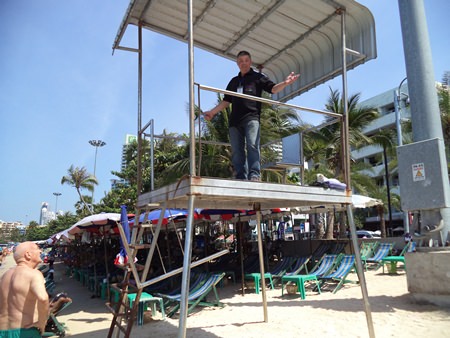For all the knocks Pattaya City Hall and local police take – justifiably – about quickly forgotten initiatives and lax regulatory enforcement, there’s little argument that Pattaya somehow has managed to become a much-nicer place than it was two decades ago.
In the mid-1990s, Pattaya Bay was so polluted by sewage that swimmers with open cuts often suffered infections within hours. Most tourists came only for Pattaya’s Sin City-style nightlife and only two hotels offered more than four stars.
 The city painted red & white no parking areas, but left some of the old white, angled motorcycle parking lines which now tend to confuse drivers.
The city painted red & white no parking areas, but left some of the old white, angled motorcycle parking lines which now tend to confuse drivers.
But after a while the local, provincial and national governments began organizing campaigns to improve the environment, economy and tourism market. There have been more than a few setbacks along the way, but a tour of Beach Road shows that progress has been made.
Mostly-smooth sidewalks, ramps for wheelchairs, pedestrian signals, bus stops, speed bumps and more now dot the beachfront landscape. Sure, most cars ignore the crossing signals and the speed bumps had to be ripped up once before they worked right, but the many tourists and street vendors say the good has outweighed the bad.
 Pattaya Beach does have lifeguard towers – bury nary a single lifeguard to be found.
Pattaya Beach does have lifeguard towers – bury nary a single lifeguard to be found.
“It’s amazing how much Pattaya has improved over the past 20 years I’ve visited the area,” said a disabled 55-year-old tourist who wishes to remain anonymous. He lauded installation of the ramps, acknowledging that, like many Pattaya projects, they took time to get right.
“Some were too steep when they were built,” he said. But, eventually, “the footpaths were finished and perfectly balanced, so I can wheel myself to any destination without the trouble of getting on and off the baht buses.”
He said many of his foreign friends have heard bad reviews about Pattaya, but he thinks the opposite is now true: Pattaya is surely worth a visit and will continue to improve.
“Nowhere in this world is perfect,” he said.
Beach visitors and vendors are hoping that will be the case for city hall’s much ballyhooed “crackdown” on Beach Road traffic scofflaws. Because, currently, it’s not working.
 Huge tour buses ignore the red & white painted kerb, and continue to park in the no-parking zone.
Huge tour buses ignore the red & white painted kerb, and continue to park in the no-parking zone.
In January, a host of regional government and police officers announced the introduction of 17 well-marked bus stops for tour buses, baht buses and taxis. The intent, they said, was to eliminate the “nonsense” that Beach Road traffic had become, due mostly to vehicles that double-parked, stopped anywhere they wanted and parked in restricted zones.
Vigilant patrols, frequent ticket-writing and aggressive vehicle-towing were promised. Supporting businesses paraded to back the initiative. And then? Nothing.
“The campaign seemed to work for a while, but I assume it was too much for public officials to handle,” said beach vendor Weechai Boonchai. “Parking has always been a problem in this area and it still is.“
Sure enough, up and down Beach Road Feb. 11, vehicles were seen double-parking and baht buses were stopped in the middle of the road. And no one was writing tickets.
Weechai said city hall also has failed to follow through on repeated promises to stop business owners from blocking off curbside parking areas in front of their shops.
“Even the major hotels do it,” she said. “My question is, do they own the area? Maybe Beach Road would look better if these selfish shop owners and hotels did not reserve public parking areas for themselves.”
Pattaya’s split personality is also apparent on the beach. The water – thanks to the sewage-treatment plant which came on line in Dec. 1999 – is now remarkably clean and clear. But swimming areas marked with orange buoys continue to be ineffective.
On this day, both swimmers and speedboats ignored the markers, setting the stage for yet another scandalous “man vs. propeller” headline. The much-touted lifeguard towers were abandoned and, of course, not a single lifeguard was to be found anywhere.




